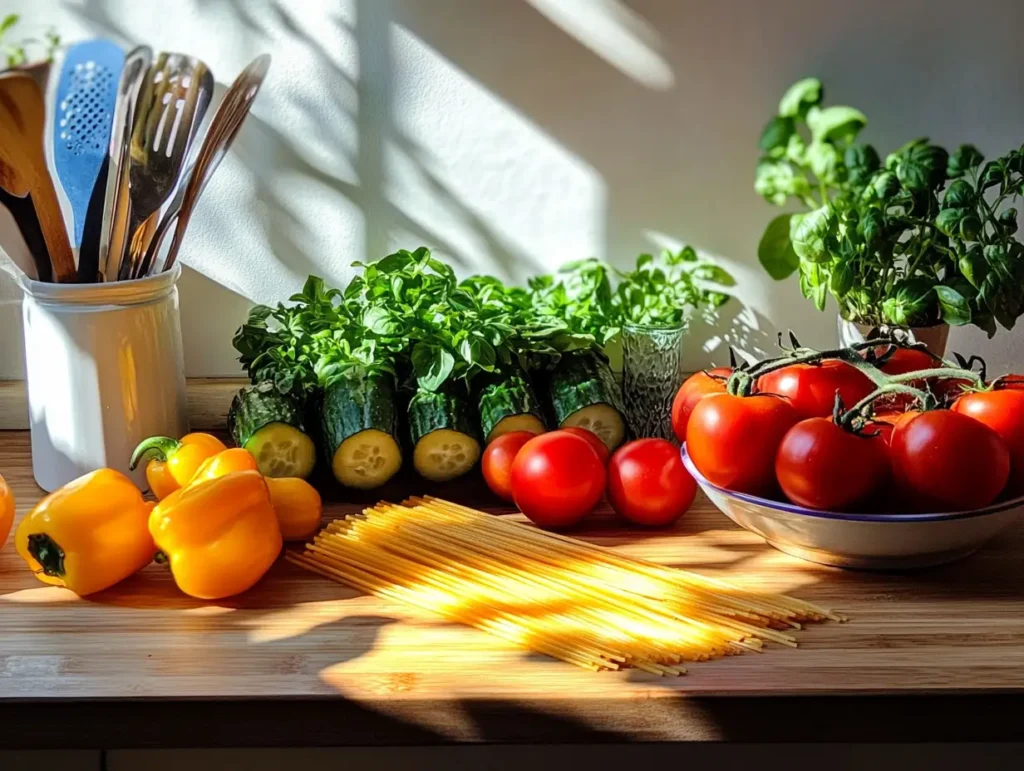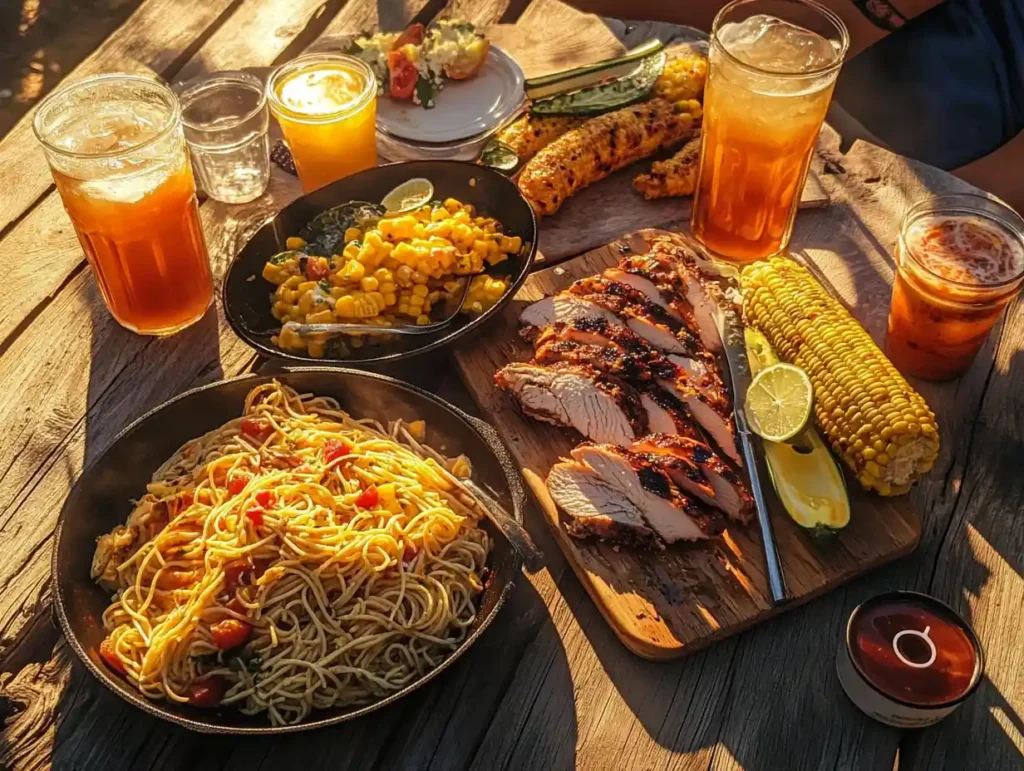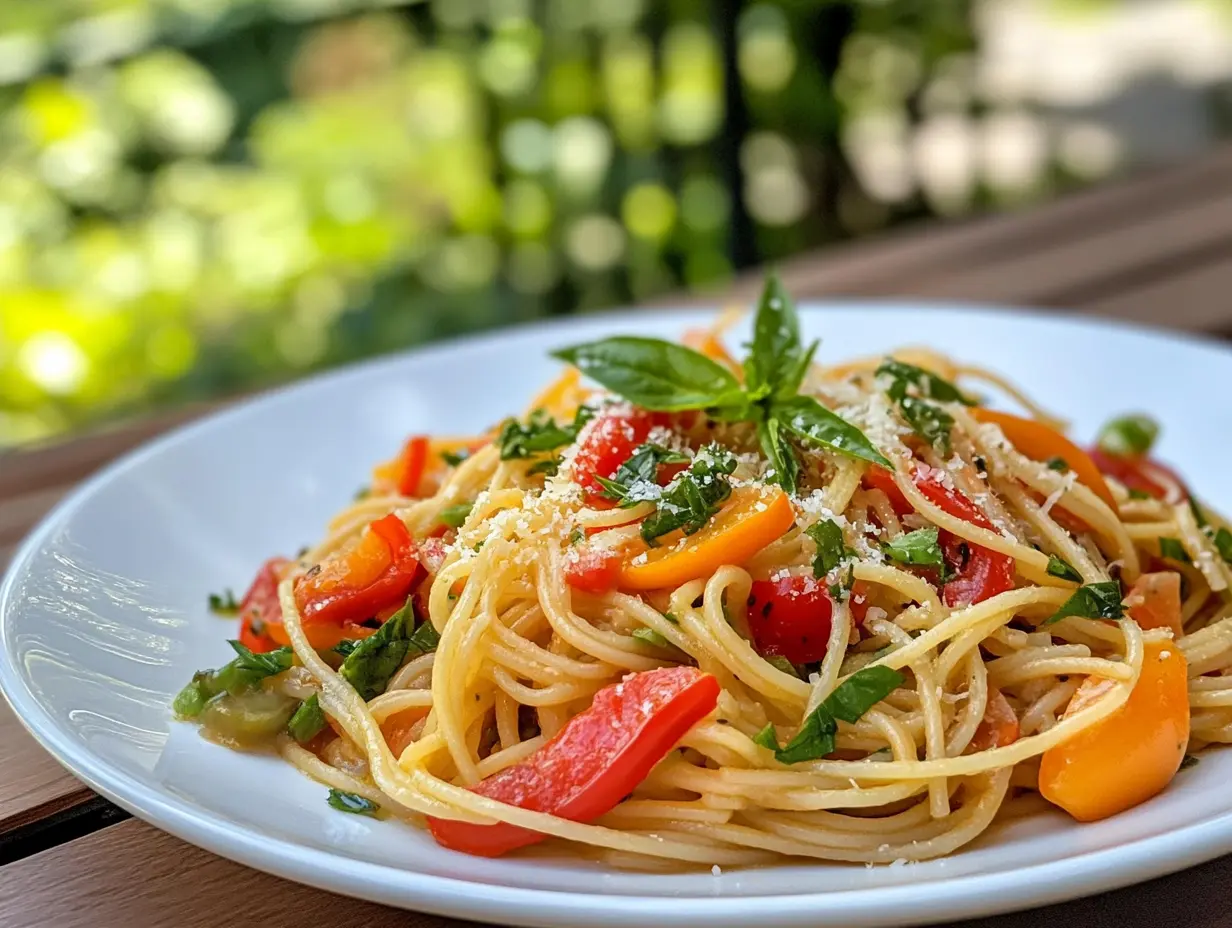Spaghetti salad is a cool, vibrant pasta dish that’s perfect for outdoor gatherings.
Table of contents
Introduction
spaghetti salad is a chilled pasta dish that brings bright flavors and crisp textures. It’s perfect for summer, yet delicious all year round. Basically, it’s a versatile recipe that brings together noodles, vegetables, and dressing to create an unforgettable side or main dish. Comparatively, this dish appeals to a wide audience because it’s simple, fresh, and adaptable. Undoubtedly, you can serve it at backyard barbecues, potlucks, or even simple weeknight dinners. Moreover, you’ll learn how to prepare it flawlessly, what ingredients to pick, and how to elevate its taste.
Eventually, you will discover its nutritional profile, serving suggestions, and answers to common questions. Ultimately, by the end of this article, you will feel confident in creating your own spaghetti salad masterpiece.
What Is spaghetti salad?
Basically, spaghetti salad is a cold pasta dish made from cooked spaghetti tossed in a tangy dressing. Indeed, it often includes fresh vegetables, herbs, and sometimes proteins like salami or cheese. Initially, people began crafting it as a refreshing, make-ahead dish that travels well. Subsequently, it became popular at social gatherings due to its appealing colors and flavors.
The Origins of spaghetti salad
spaghetti salad likely emerged as a fusion of Italian pasta traditions and American summer fare. Eventually, as pasta salads gained traction in the U.S., cooks experimented with different noodles and dressings. Consequently, spaghetti noodles, known for their familiarity, became a go-to option. Meanwhile, home cooks began mixing in olives, tomatoes, onions, peppers, and Italian dressing. Hence, the dish evolved into a delightful potluck staple.
Common Variations of spaghetti salad
There are countless ways to customize spaghetti salad. Conversely, some versions swap spaghetti for whole-wheat noodles, while others use gluten-free pasta. Comparatively, you might prefer a creamy dressing instead of a vinaigrette. Another variation involves adding protein like grilled shrimp, diced chicken, or crumbled feta. Altogether, these adjustments allow you to tailor the dish to any dietary need or personal preference.
Key Ingredients for a Flavorful Pasta Salad
When making a top-quality pasta salad, you need stellar ingredients. Particularly, fresh and seasonal produce amplifies the taste. Likewise, a balanced dressing with acidity, salt, and a hint of sweetness is essential. Furthermore, using quality spaghetti ensures a tender yet firm bite.
Choosing the Right Vegetables
Generally, crisp vegetables like bell peppers, cherry tomatoes, cucumbers, and red onions lend flavor and texture. Indeed, adding fresh herbs like basil or parsley offers a fragrant finish. Specifically, select produce at its peak ripeness for maximum sweetness and color.
Selecting Quality Oils and Vinegars
The dressing often consists of oil, vinegar, herbs, and spices. Undoubtedly, extra-virgin olive oil is a top choice for its rich taste. Additionally, consider balsamic or red wine vinegar for tanginess. Because the dressing ties everything together, it’s vital to pick oils and vinegars that complement the salad’s overall flavor.
How to Make the Perfect spaghetti salad at Home

Fresh ingredients for spaghetti salad on a rustic countertop
Making spaghetti salad is straightforward, yet attention to detail matters. Basically, start by cooking the spaghetti until just al dente. Afterward, drain it thoroughly and let it cool. Subsequently, toss with a vibrant dressing and the freshest ingredients you can find.
Selecting High-Quality Ingredients for spaghetti salad
Unquestionably, the quality of your pasta, produce, and dressing impacts the final result. Therefore, opt for premium spaghetti made from durum wheat semolina. Likewise, choose organic vegetables and fresh herbs to elevate taste. Comparatively, cheaper ingredients might lack depth, so invest in quality for the best outcome.
Preparing the Noodles for a Perfect Texture
Initially, boil your spaghetti in salted water until just tender. Eventually, test a strand for doneness and drain immediately when it’s slightly firm. Consequently, rinsing the pasta under cold water stops cooking and prevents clumping. Thus, your noodles will maintain an appealing texture in the finished spaghetti salad.
Creating a Zesty Dressing and Balancing Flavors
Chiefly, a good dressing balances acidity, saltiness, and sweetness. Undoubtedly, whisk together olive oil, vinegar, a pinch of sugar, salt, and pepper. Additionally, add dried oregano, garlic powder, or a pinch of chili flakes for complexity. Particularly, taste and adjust seasonings before mixing it with the pasta.
Recipe: How to Prepare spaghetti salad
Ingredients (for about 6 servings):
- 🍝 1 lb (450g) dry spaghetti
- 🍅 1 cup cherry tomatoes, halved
- 🥒 1 cup sliced cucumbers
- 🫑 1 cup diced bell peppers (red, yellow, or green)
- 🧅 1/2 cup thinly sliced red onion
- 🌿 1/4 cup chopped fresh basil
- 🫒 1/2 cup pitted black olives, sliced
- 🧀 1/2 cup crumbled feta or mozzarella pearls (optional)
- 🛢️ 1/2 cup extra-virgin olive oil
- 🍇 1/4 cup red wine vinegar
- 🌶️ 1 tsp dried oregano
- 🧂 Salt and pepper to taste
- 🍯 1 tsp honey or sugar (optional for sweetness)
Step-by-Step Cooking Instructions:
- Cook the Pasta:
Initially, bring a large pot of salted water to a boil. Add spaghetti and cook until al dente, about 8–10 minutes. Test for tenderness after 8 minutes, and if the spaghetti still feels firm, cook a bit longer. Eventually, drain the pasta well and rinse with cold water. This step ensures the noodles cool quickly and remain separate. - Prepare the Vegetables:
Meanwhile, wash and dice your bell peppers, slice your cherry tomatoes, and chop your basil. Slice the cucumbers into thin rounds. Also, slice the red onion into thin strips. Undoubtedly, using fresh and crisp vegetables is essential for a bright, refreshing flavor. - Make the Dressing:
In a small bowl, whisk together olive oil, red wine vinegar, dried oregano, a touch of honey or sugar (if desired), plus salt and pepper. Taste the dressing and adjust seasonings if needed. For example, add more vinegar for tanginess, or more salt if it tastes flat. Consequently, this balanced dressing will enhance all other flavors. - Combine Everything:
Transfer the cooked and cooled spaghetti to a large mixing bowl. Add the chopped vegetables, olives, and herbs. Pour the dressing over the top and toss gently. Initially, the salad might look dry, but after a few minutes, the pasta absorbs the dressing. If using cheese, fold it in at the end. Thus, your spaghetti salad will taste fresh, light, and well-seasoned. - Chill and Serve:
Cover the bowl and refrigerate for at least 30 minutes, or up to a few hours. Eventually, the flavors meld and become more pronounced. Before serving, taste again and adjust seasoning. Serve your spaghetti salad as a side dish alongside grilled proteins or as a standalone meal. Accordingly, garnish with extra herbs or a drizzle of olive oil for a final touch.
Nutritional Content (per 100g):
| Nutrient | Amount |
|---|---|
| Calories | ~120 kcal |
| Carbohydrates | ~20 g |
| Protein | ~4 g |
| Fat | ~3 g |
| Fiber | ~2 g |
| Sodium | ~80 mg |
Tips for Elevating Your Cold Pasta Dish
Basically, small adjustments take your dish from good to great. For example, marinate the salad overnight for deeper flavor. Equally, consider adding grilled chicken, chickpeas, or shredded carrots for extra texture.
Chilling and Marinating spaghetti salad for Enhanced Flavor
Eventually, letting your spaghetti salad sit in the fridge allows the dressing to penetrate the noodles. Meanwhile, the flavors mingle and intensify. Consequently, a few hours of marinating can transform a simple salad into a show-stopping dish. Thus, patience is key.
Garnishing Ideas and Extra Toppings
Undoubtedly, garnishes like toasted pine nuts, grated Parmesan, or fresh parsley elevate presentation. Additionally, add a splash of lemon juice or zest before serving. Therefore, these little finishing touches can impress guests and enhance taste.
Nutritional Breakdown of This Savory Dish
Spaghetti salad stands out as a lighter and healthier alternative to creamy pasta salads, offering a wealth of nutritional benefits thanks to its fresh ingredients and balanced composition. Packed with essential nutrients, this dish combines the goodness of vegetables, the energy from pasta, and the richness of olive oil to create a meal that’s as nourishing as it is delicious. When enjoyed in moderation and prepared with high-quality ingredients, spaghetti salad supports a well-rounded diet.
Understanding the Macronutrients
- Carbohydrates for Sustained Energy:
Spaghetti is a primary source of complex carbohydrates, which are digested slowly, providing steady energy throughout the day. Each serving delivers essential fuel for the brain and muscles, making it ideal for active individuals. Opting for whole-grain spaghetti enhances the carbohydrate profile, adding more fiber and nutrients. - Healthy Fats for Flavor and Satiety:
The olive oil in the dressing not only adds richness and depth of flavor but also contributes monounsaturated fats—known for promoting heart health. These fats help lower bad cholesterol levels and provide a sense of fullness, making the dish satisfying without overindulgence. - Protein for Muscle Maintenance:
While traditional spaghetti salad doesn’t include a significant source of protein, adding ingredients like chickpeas, grilled chicken, or crumbled feta can elevate its protein content. Proteins are essential for muscle repair, hormone production, and overall body function. For vegetarians, options like edamame, tofu, or hard-boiled eggs make excellent additions.
Incorporating More Nutrient-Dense Ingredients
Enhancing the nutritional profile of spaghetti salad is easy with a few thoughtful ingredient swaps and additions:
- Whole-Grain or Gluten-Free Spaghetti:
Swap traditional pasta for whole-grain spaghetti to significantly boost the fiber, iron, and B-vitamin content. Gluten-free options, made from quinoa or chickpea flour, cater to dietary restrictions while offering additional protein and nutrients. - Leafy Greens and Vegetables:
Incorporate nutrient-dense greens like spinach, arugula, or kale. These leafy vegetables are rich in vitamins A, C, and K, as well as minerals like iron and calcium. Adding extra vegetables like shredded carrots, zucchini spirals, or steamed broccoli increases the vitamin and antioxidant levels in every bite. - Plant-Based Proteins and Healthy Toppings:
Chickpeas, lentils, or black beans introduce a plant-based protein source while adding texture. Additionally, nuts and seeds, such as toasted almonds or sunflower seeds, provide crunch and healthy omega-3 fatty acids.
Micronutrient Highlights
- Vitamins:
The abundance of vegetables in spaghetti salad ensures a high intake of vitamins, especially vitamin C from bell peppers and tomatoes, which support immune function and skin health. Vitamin A, found in basil and other herbs, promotes healthy vision and skin. - Minerals:
Cucumbers and onions contribute potassium, a vital mineral for maintaining fluid balance and heart health. Iron from spinach and legumes supports red blood cell production and prevents fatigue. - Antioxidants:
Ingredients like cherry tomatoes and fresh herbs are rich in antioxidants, such as lycopene and polyphenols, which help combat oxidative stress and reduce inflammation.
Tips for Maximizing Nutritional Benefits
Focus on Freshness:
Fresh, in-season produce amplifies the flavor and nutrient content of the salad.
Control the Sodium:
Use low-sodium olives and reduce the amount of added salt in the dressing to make the dish heart-friendly.
Keep it Balanced:
Pair spaghetti salad with lean proteins or legumes to create a complete, balanced meal.
Serving Suggestions for Your Summer Feast

Spaghetti salad served at a summer picnic with grilled food.
Summertime gatherings often call for a dish that stands out. spaghetti salad fits the bill. Equally, it pairs well with grilled fish, juicy steaks, or veggie burgers. Additionally, it travels well for picnics or potlucks.
Complementary Side Dishes and Beverages
Serve with crusty bread, grilled corn, or a light fruit salad. Particularly, a crisp white wine or iced tea complements the tangy dressing. Moreover, sparkling water with citrus slices also pairs nicely. Consequently, the overall menu feels refreshing and inviting.
Storing Leftovers Safely
Leftover spaghetti salad keeps well in the fridge for two to three days. Nevertheless, ensure it’s stored in a sealed container to maintain freshness. Moreover, if the salad becomes dry, add a splash of oil or vinegar before serving again.
Frequently Asked Questions About spaghetti salad
Should you drain pasta for pasta salad?
Yes, always drain your pasta thoroughly. Eventually, excess water dilutes your dressing and makes the salad soggy. Meanwhile, ensure the pasta is not overcooked. Conversely, too-soft noodles won’t hold their shape. Read more
Is cold spaghetti good for you?
Cold spaghetti, when part of a balanced dish like spaghetti salad, can be a nutritious choice. Particularly, it retains complex carbs while including beneficial nutrients from vegetables. Conversely, moderation and quality ingredients ensure it fits a healthy lifestyle. Read more
Should you rinse pasta with cold water after cooking?
Rinsing pasta with cold water stops cooking and removes excess starch. Consequently, it prevents clumping and ensures a lighter texture. Undoubtedly, this step is vital for achieving a perfect spaghetti salad consistency. Read more
What is the name of the cold spaghetti?
The term “spaghetti salad” generally refers to cold spaghetti mixed with vegetables and dressing. Eventually, it became a common term for this chilled, tangy pasta dish. Indeed, it’s straightforward and recognizable. Read more
Conclusion
spaghetti salad is a versatile, simple, and flavor-packed dish that adds brightness to any meal. Undoubtedly, it’s perfect for potlucks, family dinners, or solo lunches. Comparatively, you can customize it with whatever ingredients you have on hand. Equally, you can adjust the dressing to your liking. Ultimately, spaghetti salad highlights the beauty of fresh produce and simple preparation. Therefore, embrace this dish and make it your own. Finally, serve it chilled, share it with friends, and enjoy the compliments that follow.
